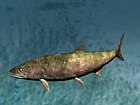Melvius

| Melvius | |
|---|---|
| Scientific classification | |
| Domain: | Eukaryota |
| Kingdom: | Animalia |
| Phylum: | Chordata |
| Class: | Actinopterygii |
| Clade: | Halecomorphi |
| Order: | Amiiformes |
| Family: | Amiidae |
| Subfamily: | †Vidalamiinae |
| Tribe: | †Vidalamiini |
| Genus: | †Melvius Bryant, 1987 |
| Type species | |
| †Melvius thomasi Bryant, 1987 | |
| Species | |
| Synonyms | |
| |
Melvius is a genus of vidalamiin amiid fish from the Late Cretaceous.[3] The type species, Melvius thomasi, was described by Bryant in 1987 from Hell Creek Formation.[4] A second species Melvius chauliodous, was named and described by Hall and Wolburg in 1989 from Kirtland Formation,[5] and it is now considered to be one of the index taxa of the Kirtlandian land-vertebrate age.[6] Both species of Melvius were very large at its size. A vertebral remain of M. thomasi would belongs to fish with standard length (length between tip of snout and the base of the caudal fin) of 161 cm (5.28 ft), and there are some specimens exceeds height of that vertebra.[4] Total length of this species would be at least 193–205 cm (6.33–6.73 ft).[7] However, M. thomasi would be a “dwarf” compared to M. chauliodous, a specimen of M. chauliodous with abdominal centra which is 6.57 cm (2.59 in) wide would indicate standard length over 2 m (6.6 ft), and there is even larger abdominal centra which is 7.3 cm (2.9 in) wide.[8]
References
[edit]- ^ Wolfe, D.G; Kirkland, J.I. (1998). "Zuniceratops christopheri n. gen. & n. sp., a ceratopsian dinosaur from the Moreno Hill Formation (Cretaceous, Turonian) of west-central New Mexico" (PDF). New Mexico Museum of Natural History and Science, Bulletin. 14: 303–317.
- ^ Brinkman, Donald B.; Newbrey, Michael G.; Neuman, Andrew G.; Eaton, Jeffrey G. (2013). "Freshwater Osteichthyes from the Cenomanian to Late Campanian of Grand Staircase–Escalante National Monument, Utah". In Titus, Alan L.; Loewen, Mark A. (eds.). At the Top of the Grand Staircase: The Late Cretaceous of Southern Utah. Bloomington: Indiana University Press. pp. 195–236. ISBN 9780253008961.
- ^ K. M. Cantalice, A. M. Martinez-Melo, and V. A. Romero-Mayén. 2019. The paleoichthyofauna housed in the Colección Nacional de Paleontología of Universidad Nacional Autónoma de México. Zoosystematics and Evolution 95(2):429-452
- ^ a b L. J. Bryant. 1987. A new genus and species of Amiidae (Holostei; Osteichthyes) from the Late Cretaceous of North America, with comments on the phylogeny of the Amiidae. Journal of Vertebrate Paleontology 7(4):349-361
- ^ L. Grande and W. E. Bemis. 1998. A comprehensive phylogenetic study of amiid fishes (Amiidae) based on comparative skeletal anatomy. An empirical search for interconnected patterns of natural history. Society of Vertebrate Paleontology Memoir 4. Journal of Vertebrate Paleontology 18(1, suppl.):1-690
- ^ Sullivan, R.M.; Jasinski, S.E.; Lucas, S.G. (2011). Sullivan, R.M.; et al. (eds.). "Preliminary Observations on a Skull of the Amiid Fish Melvius, from the Upper Cretaceous Kirtland Formation, San Juan Basin, New Mexico" (PDF). New Mexico Museum of Natural History and Science, Bulletin. 53: 475–483. Archived from the original (PDF) on 2011-09-29.
- ^ Patterson, Colin; Longbottom, A. E. (1989). "An Eocene Amiid Fish from Mali, West Africa". Copeia. 1989 (4): 827–836. doi:10.2307/1445965. ISSN 0045-8511.
- ^ Sullivan, Robert M.; Jasinski, Steven E.; Williamson, Thomas E. (2023). "The first articulated skull roof and braincase of Melvius chauliodous (Amiidae, Vidalamiinae) from the Upper Cretaceous Kirtland Formation, San Juan Basin, New Mexico". Journal of Vertebrate Paleontology. doi:10.1080/02724634.2023.2264341. ISSN 0272-4634.

